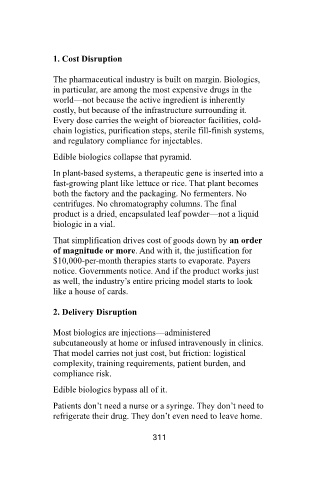Page 313 - Binder2
P. 313
1. Cost Disruption
The pharmaceutical industry is built on margin. Biologics,
in particular, are among the most expensive drugs in the
world—not because the active ingredient is inherently
costly, but because of the infrastructure surrounding it.
Every dose carries the weight of bioreactor facilities, cold-
chain logistics, purification steps, sterile fill-finish systems,
and regulatory compliance for injectables.
Edible biologics collapse that pyramid.
In plant-based systems, a therapeutic gene is inserted into a
fast-growing plant like lettuce or rice. That plant becomes
both the factory and the packaging. No fermenters. No
centrifuges. No chromatography columns. The final
product is a dried, encapsulated leaf powder—not a liquid
biologic in a vial.
That simplification drives cost of goods down by an order
of magnitude or more. And with it, the justification for
$10,000-per-month therapies starts to evaporate. Payers
notice. Governments notice. And if the product works just
as well, the industry’s entire pricing model starts to look
like a house of cards.
2. Delivery Disruption
Most biologics are injections—administered
subcutaneously at home or infused intravenously in clinics.
That model carries not just cost, but friction: logistical
complexity, training requirements, patient burden, and
compliance risk.
Edible biologics bypass all of it.
Patients don’t need a nurse or a syringe. They don’t need to
refrigerate their drug. They don’t even need to leave home.
311

